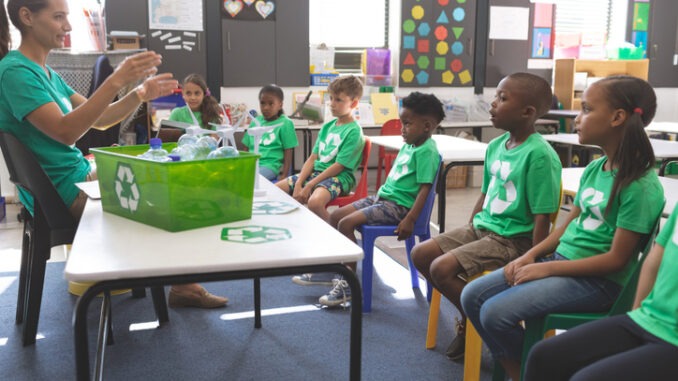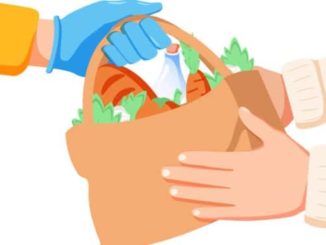
As reported by the Guardian, the UK government has failed to back up its call for schools to ditch plastic, say campaigners, despite setting a 2022 target
Three years ago Damian Hinds, then the education secretary, challenged headteachers in England to ditch disposables such as straws, bottles, bags and food packaging by this year. But campaigners say that without tangible targets, funded resources and a realistic strategy, this goal is still a long way off.
After the announcement, the environmental charities Surfers Against Sewage (SAS) and Kids Against Plastic (KAP) saw a flurry of interest from teachers and pupils wanting to join their school-based initiatives. About 4,500 schools have signed up to programmes, but these represent just 14% of UK schools.
The guidance was “much too vague”, according to Amy Meek, who co-founded KAP with her sister Ella in 2017 and launched the Plastic Clever Schools initiative in spring 2018.
“We were excited to see the government target because it felt like a step in the right direction; they were acknowledging the importance encouraging schools to take action,” she said. “But ‘eliminating unnecessary single-use plastic’ is hard to quantify – what falls into that category? How do they want schools to go about it? There was so little for schools to actually build upon.”
“We really thought that announcement would help make change happen but since then so little has been done; what’s the point of setting a target if nothing was going to happen towards it? It didn’t make sense to us that they would set this goal and then do nothing.”
So far, more than 1,300 schools have signed up to the Plastic Clever Schools initiative. Another 3,174 schools have signed up to the Plastic Free Schools programme that SAS established in September 2017.
Hugo Tagholm, the chief executive of SAS, is also disappointed. “[The government] shouldn’t be making bold statements and commitments unless they really know what their pathway to delivering the success is. Otherwise it’s disingenuous.”
Emily van de Geer, the education manager at SAS, says the Plastic Free Schools programme helps teach students to hold power to account by challenging government representatives and industry. “We’re providing young people with the tools to use the power of their voice and know that those avenues of communication to politicians and business owners are open to them in the future.”
To reach Plastic Free School status, schools must also remove at least three single-use plastic items from use, either by ditching them altogether or choosing reusable alternatives.
But when schools are tied into multi-year contracts with suppliers, procurement is a barrier, says Van de Geer. “If government introduced stronger bans – of plastic drinks bottles in schools, for example – those companies would have to change the way they are supplying schools. That pressure needs to come from the top, too.”
A Department for Education spokesperson said: “The government wants schools to be single-use plastic-free. We know many schools have met this ambition and others have made significant progress towards it. The government has launched a call for evidence looking for views on how to shift away from single-use items to reusable or refillable alternatives.”
Tagholm says new regulations are needed to make a substantial transition. “Just look at what’s happened with deposit return schemes: we won that battle in 2018 but the government is still dragging its heels. It’s a really achievable, sustainable solution to plastic pollution from bottle and drinks containers that we see on every beach and street of the country,” he says. “But instead of putting in good legislation, they seem reliant on voluntary measures. That’s not a systems change.”
Van de Geer remains hopeful: “2022 is an opportunity [for the government] to reflect on the 2018 announcement, acknowledge that not enough support has been provided to reach those goals and lay out some more concrete support for schools to achieve this in the future,” she says. “Schools need a roadmap.”
For sisters Amy and Ella Meek, their Plastic Clever Schools project is about shifting mindsets.
“Becoming ‘plastic clever’ is a realistic first step towards tackling plastic pollution,” says Amy, 18. “Being completely plastic-free is so unachievable for most people, never mind overworked teachers. So a big part of our programme focuses on enabling the youth voice, getting kids to start to lead this in the school so that … they’re much more likely to want to do more at home and elsewhere in their community.”
When a school signs up to Plastic Clever Schools, the website guides teachers and pupils through a three-stage process. First up, lesson plans help teachers educate primary pupils about the impacts of plastic pollution by building a base level of awareness. By the end of this first stage, pupils present an assembly about plastic pollution to the school, organise a litter-pick and create a video explaining the importance of reducing plastic.
In stage two, students audit the single-use plastic in their own school to quantify the problem. “Schools vary in terms of the stage they’re at and the types of plastic they use most of, so each school needs to decide which four problem plastics they want to eliminate,” says Ella. “For some it might start with crisp packets in packed lunches, for others it could be glue sticks or milk bottles.”
The final stage is about action. “Having done the audit, pupils campaign to reduce four items of single-use plastic across the whole school – that’s the ultimate goal,” says Ella.
The duo hope to make the model scalable to reach more primaries and secondaries in the future.





Be the first to comment